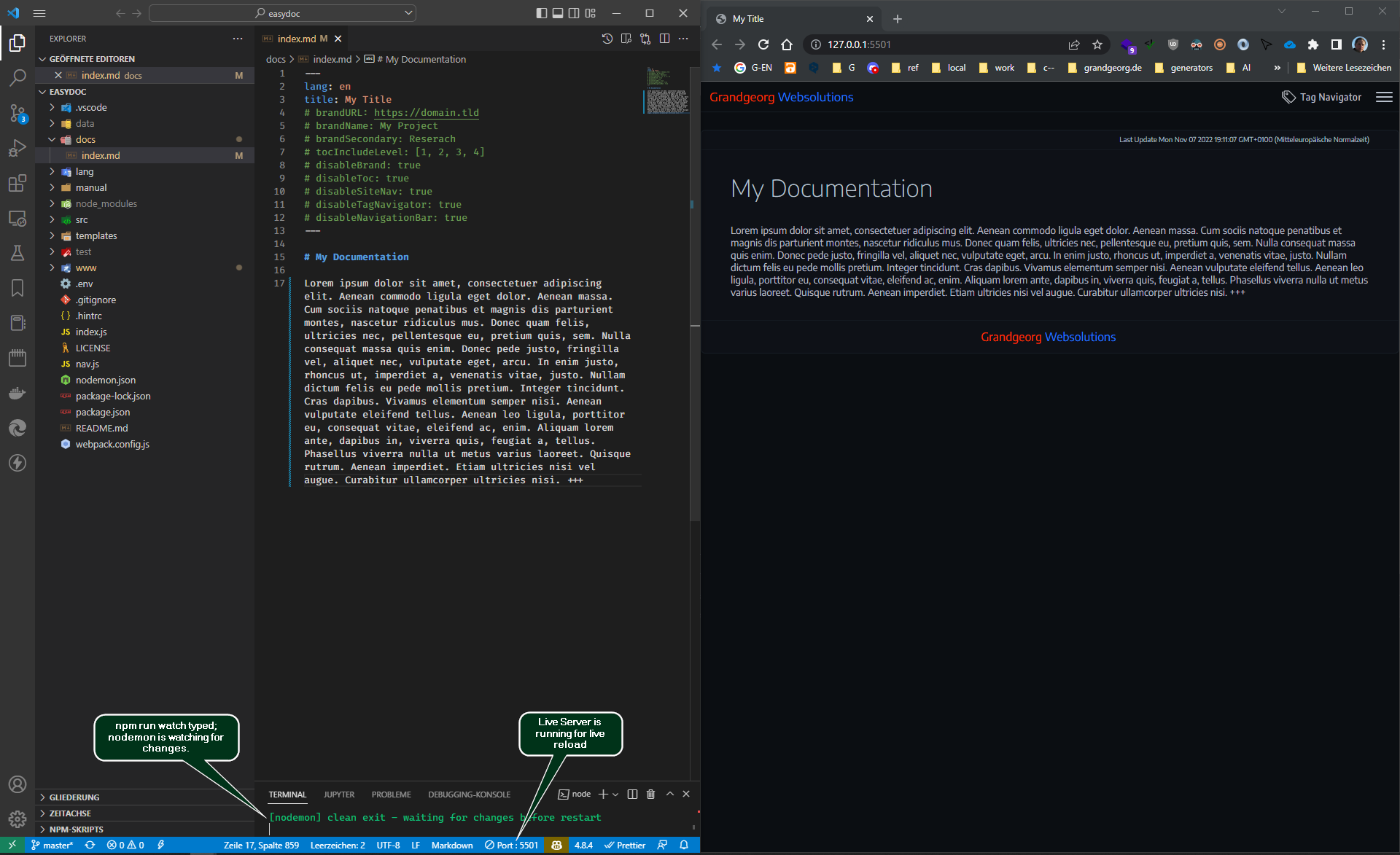EasyDoc

A powerful technical documentation tool that generates completely local HTML pages and websites from markdown files.
created by:
Grandgeorg
Websolutions
Features
Generates completely local HTML Website.
- You can just open the resulting HTML-files in the
wwwdirectory locally (from filesystem) in a browser. - You can also drop / push the contents of the
wwwdirectory to a HTTP-Server.
Rich markdown support and code highlighting features
- Uses markdown-it with plugins for markdown to HTML rendering
- Uses Prism with plugins to highlight code.
Fully configurable and customizable
- Configure global and per page settings (see reference for details).
- Customize all components as you like.
- Edit SCSS files (under
src/scss) to change theme. - Edit
app.jsto change navigation etc. app.jsuses pure vanilla JavaScript without any dependencies.
Built in Navigation
- Table of contents on pages
- Individual site navigation
- Tag Navigator module
Install
Clone with git from master branch:
# clone via https:
git clone https://github.com/grandgeorg/easydoc.git
# or clone via SSH (if you have a key):
git clone git@github.com:grandgeorg/easydoc.git
Change into easydoc directory and run install:
cd ./easydoc/
npm install
You could now use EasyDoc from this directory, but we recommend, that for your documentations in different paths you use the setup.js from EasyDoc as follows:
# cd to some directory in some project of yours, where you want to setup your documentation with EasyDoc
cd /some/project/docs
# run setup.js from easydoc with node
# e.g. node D:\\srv\\vhost\\easydoc\\index.js
# in powershell you can use the following command:
# node (Get-Item -Path "D:\\srv\vhost\easydoc\index.js").FullName
node /path/where/you/cloned/and/installed/easydoc/setup.js
# edit newly generated config files (.env, nav.js, package.json - author, description, keywords) in /some/project/docs ...
# put some md-files into docs directory
# you can now run
npm run build
# if you also want to use nodemon to watch your file changes first run
npm install
# then you can run
npm run watch
Usage
# watches on file changes and runs build:
npm run watch
# or build one time
npm run build
🖿 easydoc directory structure
🗁 easydoc
├🗀 .git
├🗀 .vscode
├🟢 docs
│ └🗏 index.md 🖤
├🗀 lang 🖊️
├🗁 manual 📌
│ ├🗀 assets
│ ├🗀 img
│ ├🗏 easydoc.html
│ ├🗏 easydoc.md
│ ├🗏 easydoc-reference.html
│ └🗏 easydoc-reference.md
├🗀 node_modules
├🗀 setup 🖊️
├🗀 src 🖊️
├🗀 templates 🖊️
├🔵 www
│ ├🗀 assets 🖊️
│ ├🟢 img
│ ├🗏 index.html 🖤
│ └🗏 meta.js 🖤
├🗏 .env ✏️
├🗏 .gitignore
├🗏 .hintrc
├🗏 index.js 🖊️
├🗏 nav.js ✏️
├🗏 nodemon.json
├🗏 package.json
├🗏 package-lock.json
└🗏 webpack.config.js
╭──────────────────────────═━┈💬┈━═──────────────────────────╮
│ 🟢 input directories. Start creating files here. │
│ 🔵 output directory. Html files will be generated here. │
│ ✏️ configure EasyDoc │
│ 🖊️ change EasyDoc │
│ 📌 It's me. You are reading these documents right now. │
│ 🖤 Remove these documentation files for a blank start. │
╰──────────────────────────═━┈💬┈━═──────────────────────────╯
For configuration and further usage refer to the EasyDoc Reference
Workflow
For the most convenient use do the following:
- Start Visual Studio Code from the
easydocdirectory. - Start the Live Server extension.
- Run
npm run watch. - Put the vscode and the browser window side by side.
- Start creating and editing markdown files in
docsdirectory. - Use git if working in a team.
Workspace Example Screenshot
